 |
||
|
||
| ||
The field full of VIA P4X266 mainboards is in bloom now. The plants are carefully cultivated, though it is quite dangerous today to give new names to new sorts; therefore, all plants are labeled as "grown in the gardens of Marquis VIA" and then packed in identical boxes with letter "V" on top. Some gardeners do not meddle with reception of labels on the main entrance and sell what they grow up themselves. That is why a stamp of VIA is like a certificate of conformance and a vet certificate in one. Today we are going to go for a walk onto a new tilled field. VIA keeps on giving preferential lease terms for the same sum of money, and it means that new harvest will mature soon. VIA P4X266A chipsetThe P4X266 chipset was discussed a lot all throughout the Net, that is why we will just focus on the differences of the new chipset (for details on the P4X266 see our August Review). 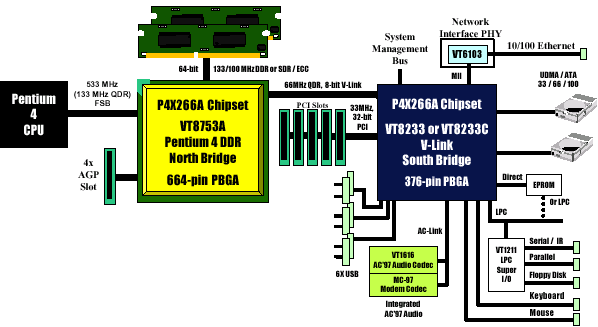 First of all, they added a support for future Intel Pentium 4 processors with a 533 MHz bus (133 MHz QDR). Once we tried to convince you that upgrade is impossible, but this sweet word will probably never stop drawing money out of your pockets. Well, this new feature can be recorded as an advantage of VIA, but will we be protected from flashing a new BIOS or looking for a new board on a new stepping for the new processor? The figure above doesn't indicate it, but the chipset also works with today's processors of 400 MHz (100 MHz QDR). One more change in the processor bus was a 12-level instruction queue. 533 MHz processors are not yet a today's benefit, but improved operation of the memory controller is already noticeable, though it still works with memory up to 4 GB at 100/133 MHz, SDR/DDR, with/without EC/ECC. The real changes are hidden in "improved timings and deepened queues. The history of the VIA's chipsets makes me think that a real speed gain will be up to 10%.  And that's all. Two versions of the south bridge coming with the VT8753A are the same; the V-Link bus is also the same; the north bridge hasn't undergone any changes as well. The only thing left to mention is V-MAP (VIA Modular Architecture Platforms). The idea is that a chip of the current north bridge VT8753A is pin-compatible with VT8753 (P4X266) and VT8751 (P4M266). Southbridge chips VT8233, VT8233C and VT8233A (future, with ATA133 support) are also interchangeable. It doesn't matter much for an ordinary user, but a possibility to use the same design for boards on all modern VIA chipsets seems to be attractive for mobo developers. BoardsHere is a comparison table of all boards participating today in our tests:
VIA P4XB-RA & P4XB-SA These boards differ only in IDE RAID, that is why we will examine them together. 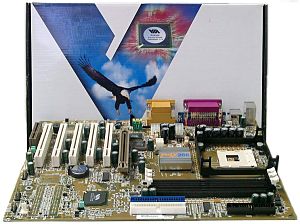 The box of a typical VIA's design have a weighty installation manual in English, two ATA66/100 and one FDD cables, a bracket for a rear computer panel with 2 USB ports and a CD with drivers. 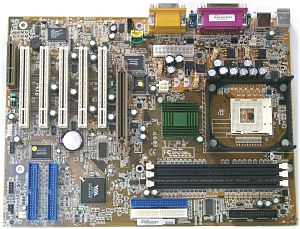 The boards have a convenient layout. There is a sound controller for a 6-piece audio system, and a connector to put audio-outs onto a front computer panel. An AGP connector has a clip to prevent a video card from falling out, but it is quite difficult to open it. The VIA P4XB-RARAID controller form Promise allows increasing operation or reliability of a disc subsystem. Of course, IDE RAID connectors can be used just for 4 additional ATAPI devices. The core feed circuits have a three-phase voltage stabilizer. Two switches serve for clearing the CMOS and for enabling/disabling an integrated audio codec.  The BIOS is based on the Modular 6.00 from Award. It offers a great deal of settings for memory timings and frequency, provides adjustment of AGP and PCI buses and a manual distribution of interrupts among PCI slots. You can also change a CPU frequency (in 1 MHz steps), its multiplier and processor and memory voltages. Both boards have a rich set of features and an excellent speed of operation. VIA PR22-R (Soltek 85DRV+)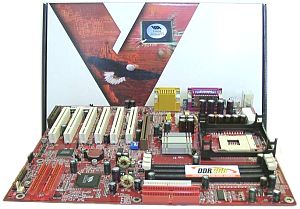 This is already the second board from Soltek on this chipset in our lab. The board hasn't changed much, but the package is different: a noname box is replaced with a box typical of VPSD with a user's manual in English, ATA66/100 and FDD cables, an additional thermistor and two CDs. One of the CDs contains drivers, Adobe Acrobat Reader and several utilities for system monitoring. The other contains PCCillin 2000,Virtual Drive 6.0 utilities and two applications from PowerQuest "PartitionMagic 6.0 and Drive Image 4.0. 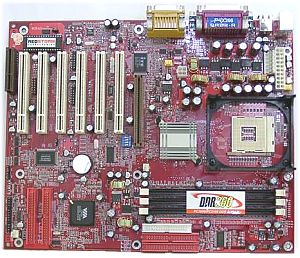 The quality of the board is quite good, including soldering and attachment of all components. But the layout is not the best: connectors of additional USB ports and one of a Smart Card reader are located between PCI slots, a CD-in is put in front of the first PCI and AGP slots. But we should allow for the fact that this board serves a base for several versions: this one contains an IDE RAID controller and its connectors; there is also space for the second serial port. The board comes with 13 LowESR capacitors of 2200 uF each. Switches are meant to clear the CMOS, enable/disable Suspend-to-RAM function and permit/forbid records into EEPROM. DIP switches can help you choose a base FSB frequency. The BIOS is based on the 6.00PG Modular BIOS from Award. It offers a great deal of settings for memory timings and frequency, provides adjustment of AGP and PCI buses and supports SmartDoc Anti-burn Shield technology from Soltek. You can change voltages of memory, an AGP bus and a processor, and a FSB frequency in 1 MHz steps. This board has disappeared from the VIA's site and hasn't yet appeared at the Soltek's one. But new BIOS versions can be found in their technical support service. Well, it's not a revolutionary product, but it is still a reliable a highly efficient base for a computer. VIA PE11-S This board is very similar to what DFI produces: yellow color of the PCB, a plate on the back side which protects the board if it is bundled with huge coolers, fonts that mark connectors etc. The box contains a user's manual in 7 languages (150 pgs), ATA66/100 and FDD cables and a CD with drivers, an e-version of manual, PCCillin 2000 and system monitoring utilities. 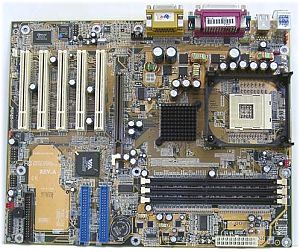 The layout has some drawbacks (IDE and FDD connectors are located behind PCI slots, and typical problems with audio-outs) and some advantages (high-quality soldering, a clip on the AGP slot and 13 LowESR capacitors of 2200 uF each). The PCB can be supplemented with a network controller on a Realtek's chip. Two switches serve for clearing the CMOS and for starting up a computer with a PS/2 keyboard&mouse. The BIOS is based on the 6.00 Modular BIOS from Award. It offers a great deal of settings for memory and provides adjustment of AGP and PCI buses. Here you can set a CPU multiplier and a FSB frequency and distribute manually interrupts among PCI slots. This board works very stable but its speed characteristics are not impressive and an overclocking potential is not great. VIA VL33-S This board from VIA is quite ordinary, but its peculiarity is that it uses the old Socket 423. The board comes with ATA66/100 and FDD cables and a CD with drivers and monitoring programs. 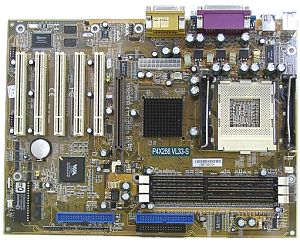 The quality of the board is quite high: all add-on components are conveniently placed, and functional connectors are easy to reach. The AGP slot has a clip so that a video card wouldn't fall out. 13 LowESR capacitors of 2200 uF each make the operation very stable. Switches are meant only for standard operations like CMOS clearing. The BIOS based on the v6.00PG from Award provides a wide range of features for adjusting memory timings, and AGP and PCI buses. You can manually distribute interrupts among PCI slots. Vcore can be changed in 0.025V steps up to +0.2/-0.1V, and Vmem can be altered up to +0.35V in 0.05V steps. A FSB frequency can also be changed in 1 MHz increments. The board gives good impression, but it suits only for owners of old Pentium 4 processors. PCPartner P4X266AS4-241 Large companies do not risk of their relations with Intel and either produce their boards on this chipset without any signs or do not produce them at all. Some other companies promote their boards under a new trade mark which belongs to the manufacturer of the chipset. And small businesses do not risk at all, that is why they produce such boards under their own name, like PCPartner i845. The box houses a user manual, ATA66/100 and FDD cables and a CD with drivers, a utility for flashing new BIOS versions and PCCillin 2000.  The layout is not very good, an AGP slot lacks for a clip but there are LowESR capacitors " 9 of 3300uF and 2 of 2200uF. Besides, there are two connectors for 12V voltage, one of which is meant for a connector of hard drives which can be useful for owners of old ATX power supply units. The board also incorporates a connector to output audio-outs onto a front computer panel. Two switches serve for clearing the CMOS and for enabling/disabling an integrated audio codec. The BIOS is based on the v6.00PG from Award and provides possibilities to adjust memory timings and AGP and PCI buses. A CPU multiplier can be changed but it is useless for production samples of Pentium 4. It should be noted that all default settings for performance (of memory, a hard drive etc.) have the worst values, that is why you should change them. Manli M-P4266/X The box of a typical design contains a scarce user's manual (20 pgs), ATA66/100 and FDD cables and a CD.  The CD contains an antivirus pack from Trend Micro ($40), drivers and utilities for flashing new BIOS versions. When we compared this CD with that of PCPartner it turned out that everything, including a date of file creation, was identical. Furthermore, these boards seem to be differ only in a PCB color, that is why we won't dwell on this board any more. You can just read the above paragraphs once again :) In closing I'd like to say that it's the slowest board among all. Anyway, the gap is not huge, but the price is quite low. PerformanceTest system:
Software:
Test results: Some spread in values in this test (which doesn't depend much on the memory) doesn't clear up the things. The only thing to be noted is that the VIA P4XB-RA and VIA P4XB-SA finish together " and it was expected as a RAID controller is not used for connecting a hard drive on the first board, and there are no more differences between these models. 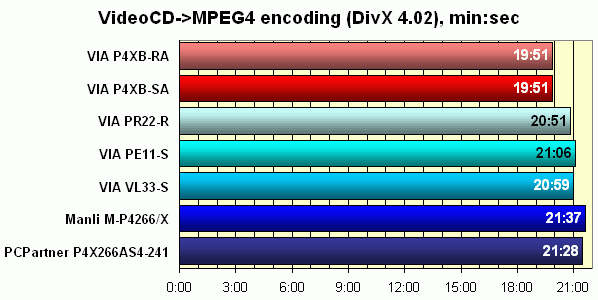  These memory-intensive tests demonstrate an advantage of the new VIA's chipset over the old one by 5–9% in operations with memory, and brand-name boards on the P4X266 over the rest on it by 7–15%. Well, the gap is quite big.   The business tests of the Winstones 2001 set show sudden results, that is why we shouldn't trust it entirely and let's wait for the Winstones 2002. On the whole, the VIA P4X266A takes a 3–4% lead, all P4X266 based boards go on a par, with the VIA PR22-R looking a bit better. This test is very much dependent on operation with a hard drive, and all the boards have the same south bridge which controls its interaction.  The tests of professional OpenGL applications show an interesting distribution of all boards among the performance components:
The VIA PE11-S looks a little worse than the rest.  This old game with unsophisticated graphics is not able to load the GeForce3 entirely, that is why the results in high and low resolutions coincide and show a 10% advantage of the "A" chipset over the old one. A greater speed is achieved at the expense of the "processor-memory" link.  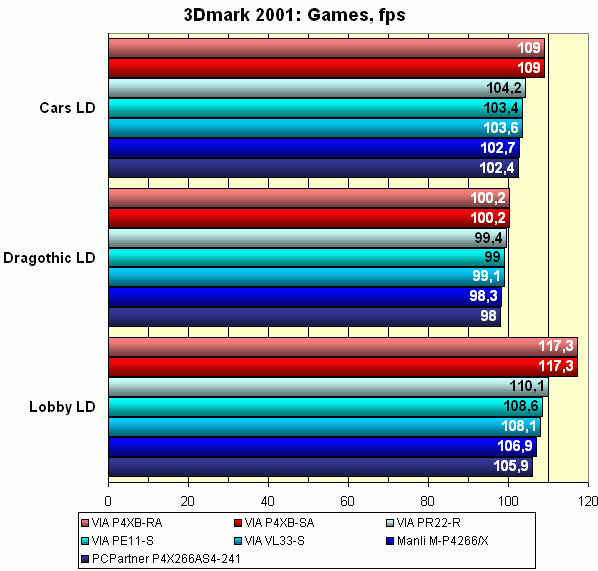  These aging (though younger than the previous ones) games smooth the difference to 5% in low resolutions, and in high ones they limit the performance by a 3D accelerator. The P4X266 based boards form stairs with a difference of 2-3%. 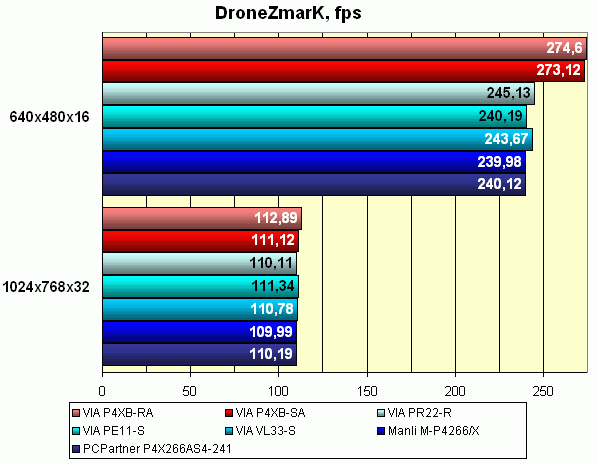 At last, the DroneZ returns a 10% advantage to the VIA P4X266A in low resolutions; the boards on the old chipset score close results. Here the new chipset speeds up the link of the memory and the video accelerator. The VIA PE11-S comes the last among the three in the games. ConclusionSo, first of all, the VIA P4X266A vs. VIA P4X266: everywhere when a speed of operation with memory can accelerate operation the new chipset thrives by up to 10%. On the other hand, when choosing a chipset remember that there are quite good alternatives: SiS 645 and Intel 845D (see the SiS645 and i845D reviews). Moreover, if you need a powerful computer just for games you'd better take a more expensive video accelerator and a board based on the old chipset as the difference between the old and the new ones won't be noticeable in this case. Secondly, the difference between boards made by VIA and other, little-known ones is considerable. Although the latter have a lower price we would recommend you to go with a higher-quality and speedier product. So, among the boards we tested today I'd like to mark out the VIA PR22-R and the VIA VL33-S which are not direct competitors as they are meant for different sockets. Maybe, there are not so efficient samples from VIA, but so far we have
seen only a high-quality VIA P4XB-RA/SA board.
Write a comment below. No registration needed!
|
| |||||||||||||||||||||||||||||||||||||||||||||||||||||||||||||||||||||||||||||||||||||||||||||||||||||||||||||||||||||||||||||||||||||||||||||||||||
Platform · Video · Multimedia · Mobile · Other || About us & Privacy policy · Twitter · Facebook
Copyright © Byrds Research & Publishing, Ltd., 1997–2011. All rights reserved.